What Do You Do With Your Stone Remnants?
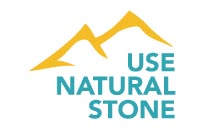 Stephanie Vierra
Stephanie Vierra
usenaturalstone.com
Natural Stone Institute
Stone takes thousands, and in some cases, millions of years to be formed by the Earth, and will last for many more years once it is installed in a project. Therefore, careful thought and attention should be paid to designing, constructing, and using natural stone correctly and efficiently so waste is reduced or eliminated. Attention is also being paid to reducing waste in the construction and demolition processes, and in the quarrying and fabrication processes of natural stone as well.
Sustainable approaches to addressing waste at every step of the process conserve water, electricity, and the materials themselves. The leftover materials from fabrication or construction are known as remnants. Natural stone remnants can be used somewhere else in a project or in another project entirely and should not go to waste or end up in a landfill. There are many different ways to address this issue and many advantages to identifying and using natural stone remnants in a project
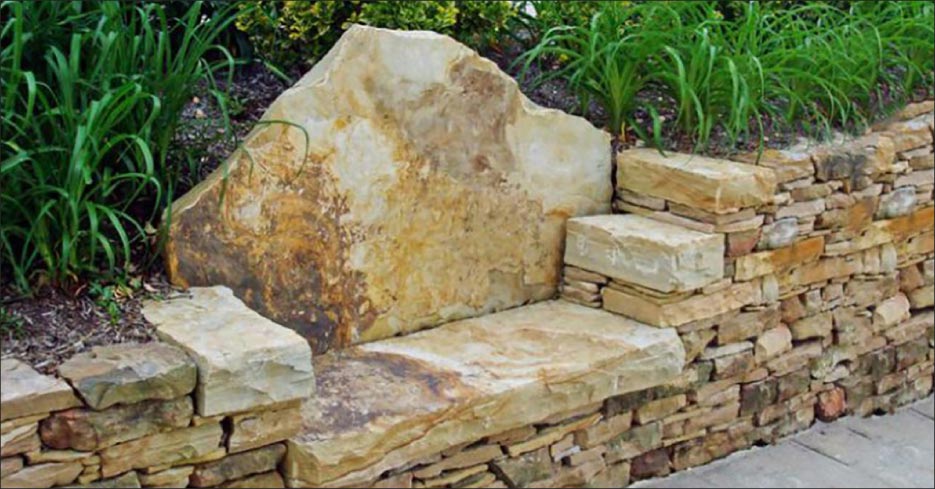 |
|
Above: A combination retaining wall and bench made from stone remnants. |
 |
|
It is estimated that 170 million tons of construction debris is produced every year in the U.S. alone.
|
Ways to Reduce Waste
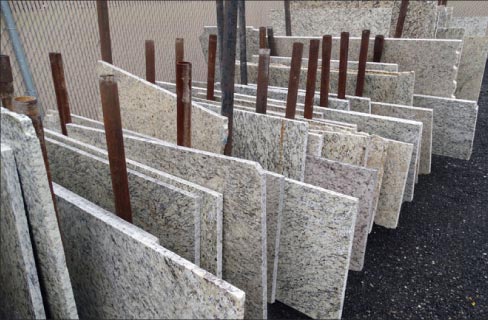 |
|
Granite remnants at a stone yard safely stored and reserved for selection and fabrication. |
Several key steps should be taken to reduce waste before it is even generated. You or your project team should be prepared to ask a number of key questions during every stage of the project. What can be done at the beginning of the design process to address waste? Plan well by designing the project in detail before finalizing any orders.
Computer modeling and programs like Building Information Modeling (BIM) can keep accurate records of materials needed for the specific design and will revise the amounts when a change is made in the BIM model. Are there any design strategies that would help ensure that only the exact amounts of a material needed for a project are ordered? Use standard and consistent measurements and sizes on a project whenever possible.
This will contribute tremendously to less waste, because the stone will be easier to fabricate and simplifies the packaging of the material. The project will also be easier to construct. How can using one type of stone reduce waste? Different looks can be achieved by simply applying different finishes to the same stone, which will reduce the amount of stone that needs to be quarried and fabricated.
What type and how much packaging is necessary to complete an order? Coordinate with the supplier to reduce the amount of packaging that is used or needed for the stone. Packaging should also be recyclable whenever possible. What can be done with any leftover stone? Some stone suppliers have buy-back policies. Be sure to ask about this in advance to know what your options are for returning unused stone.
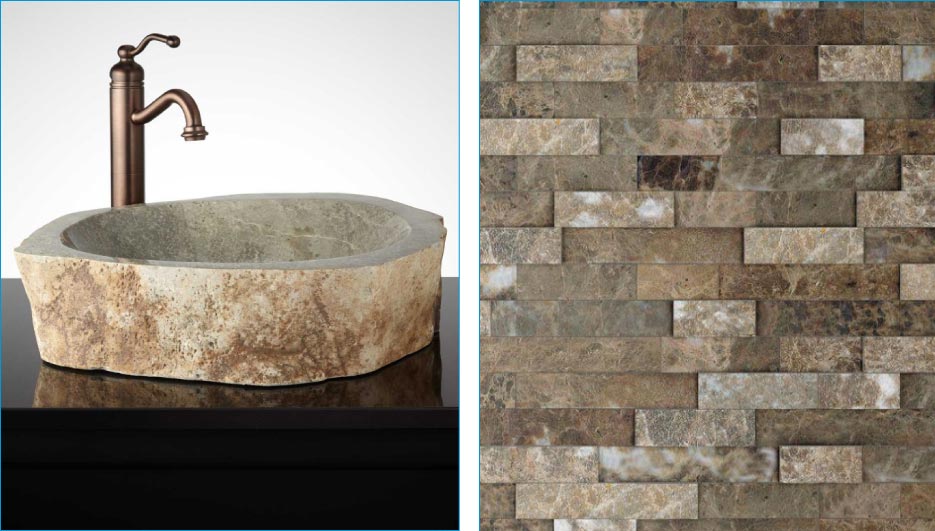 |
|
Simple, elegant indoor uses for stone remnants including vanity countertops, backsplashes, and bowl sinks. |
Where is the best place to finish the stone? When a stone is finished off-site in advance of arriving at a job site, this helps to reduce and eliminate waste. Any time a contractor has to finish or further cut materials onsite, this will cause waste. Ask to have as many of the finishing and details done offsite before the materials arrive on the project site. How can the stone remnants be used?
Stone remnants, whether large or small, can be created into accent pieces or support another design element. There are a few additional things you should consider before you decide to work with remnants. Your choices of stone types may be limited if you want to work with remnants. However, stone remnants, including granite, quartzite, marble, limestone, travertine, and many others, can be found at stone yards or fabricators in various shapes, sizes and quantities. They tend to be small pieces, so that may limit what can be done with them or how they can be used.
The stone might be damaged, perhaps with scratches that came from saws, grinders, or from being outside and exposed to wind, rain, and the elements. Some of these issues can be resolved through further cutting or polishing, or eliminating those pieces from the project. Make sure to ask for the highest quality remnants so you can be assured that the end result will be of a high quality as well. This approach to using remnants can also save money, since many companies will offer discounts on these materials that would otherwise go to waste.
Remnants are often turned into smaller decorative objects or feature elements such as a tabletop, backsplash, cutting board, small countertop, mosaics, or a fireplace hearth. How about a unique, one of a kind, bowl sink made from a leftover block of stone? Even something as simple as a window sill, shower threshold, or bench can be made using stone remnants. Landscape elements including patios, fire pits, grill surrounds, planters, and paving are great for outdoor applications with the appropriate stone remnant chosen for the environment and conditions. Remnants also offer wonderful opportunities to create rooms and spaces that flow together with elements in other spaces and the materials, colors, and patterns will be coordinated across the stone palette.
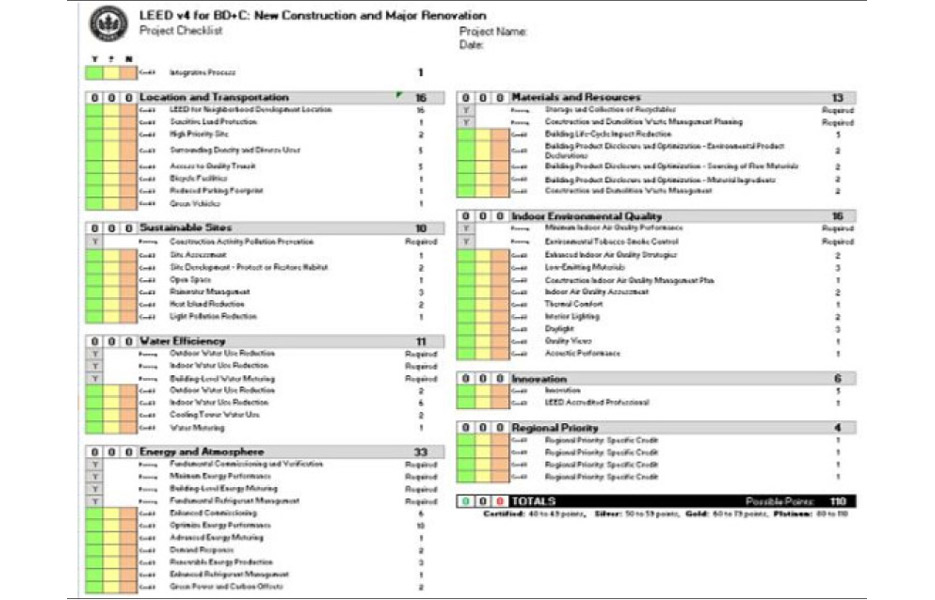 |
| Partial LEED Checklist for New Construction and Major Renovation projects showing Materials and Resources credits. |
How Natural Stone Remnants Can Help with LEED Certifications
The LEED Rating system offers approaches to reducing construction waste for many different project types seeking Certification.
Project designers and teams can achieve points in two different categories, essentially in the planning and management of waste. The LEED category Construction and Demolition Waste Management Planning is a Prerequisite, meaning that it is required for the specific LEED project type for which Certification is being sought.
The intent is to reduce construction and demolition waste that would otherwise end up in landfills and incineration facilities by planning for it. The goal is to recover, reuse, and recycle materials instead. Project teams need to develop waste diversion goals by identifying at least five materials (both structural and nonstructural) that are targeted for diversion that is based on a percentage of the overall project waste. You must also specify whether the materials will be separated or commingled and describe the diversion strategies planned for the project.
So instead of natural stone ending up in a landfill, this plan could help you identify other ways to use the stone either in your current or future project. After the plan is created, the approach to handling the waste must be managed. This is addressed in the Construction and Demolition Waste Management LEED Category. The intent is the same as the Planning category. However, the requirements are to recycle and/or salvage nonhazardous construction and demolition materials. Calculations can be by weight or volume but must be consistent throughout the process. There are different options for achieving these credits including diversion or reduction of the total waste material.
It is important to coordinate the LEED credits with other team members and even the stone supplier and installer so that everyone does their part to support the process. Early communication, coordination and again, planning, are key to making these credits achievable. Since the materials being recycled or diverted have to be weighed or measured, develop a coordination and communication plan with everyone involved in those areas of responsibility to ensure that appropriate containers are provided and necessary documentation that has to be submitted is understood and completed in the time-frame required.
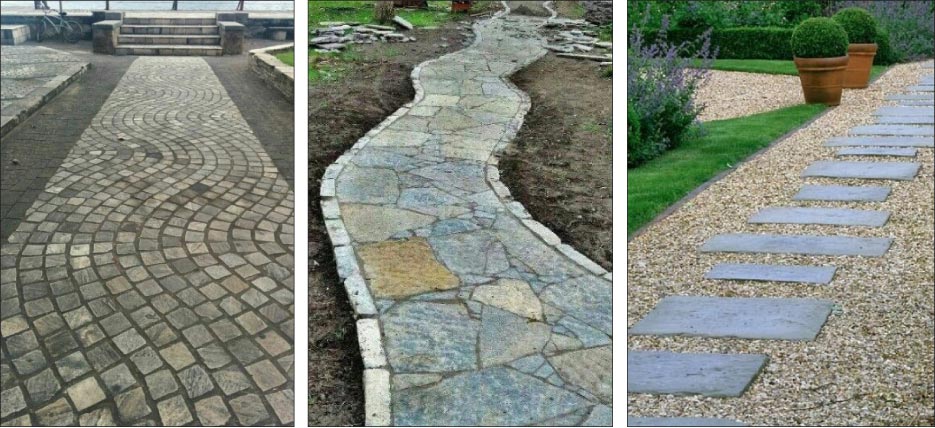 |
|
Many different patterns and configurations can be achieved using stone remnants for outdoor paths and paving. |
Natural stone remnants offer endless opportunities for creative uses in your next project. Just ask and you will be amazed at what is possible, given a little imagination. It may lead you down a whole new path that you had not considered before.